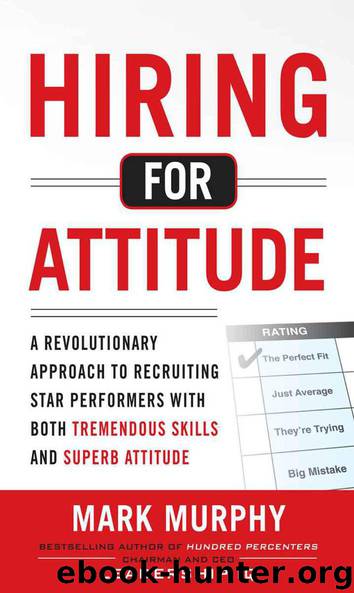Hiring For Attitude by Murphy Mark

Author:Murphy, Mark [Murphy, Mark]
Language: eng
Format: epub
Publisher: McGraw-Hill
Published: 2011-11-17T14:00:00+00:00
WHY DO WE USE ACTUAL ANSWERS?
While Leadership IQ is the only group I know of that has developed a formalized approach to creating Answer Guidelines, every once in awhile I do see somebody else attempt to assemble an interview question answer key. But instead of giving examples of actual answers, they give general admonitions such as “Look for answers that indicate adherence to ethical standards” or “Beware of answers that indicate a passive acceptance of accountability but no proactive assumption of accountability.”
There’s nothing inherently terrible about these guidelines, but they are pretty abstract, and that alone renders them woefully inadequate as teaching tools. I’m sure I’m not the only one who finds it challenging to learn in the abstract. For instance, say you were trying to teach me how to make a candidate more relaxed in an interview in order to get him to loosen up and drop his guard. You could tell me “Arrange the seating in the interview room so it puts the candidate at ease.”
That advice is fine as long as my vision of what that looks like is similar to yours (and it probably isn’t). Instead you want to say something less abstract, perhaps “Never sit across the desk from the candidate because that creates a barrier. Get out from behind the desk and arrange the chairs so they face each other. Then turn the chairs about 20 degrees away from each other. That will create a much more open and comfortable space, but it eliminates any chance of your knees hitting his.”
The latter instruction is a lot more explicit and far more actionable. Similarly, when you use clips of actual answers in your Brown Shorts Answer Guidelines, it’s a lot easier for folks to learn what good and bad answers sound like. You’re not leaving anything open to misinterpretation as you do when you provide an abstract explanation.
Of course, a lot of the real candidate answers that your Brown Shorts questions elicit are going to be long-winded and contain irrelevant details. Also, the responses will vary wildly from candidate to candidate, and you can’t plan for every possible permutation. But the snippets that appear in your Answer Guidelines don’t need to contain or cover everything that could ever be said. You just need to represent the hallmarks (Positive Signals and Warning Signs) of the good and bad answers so both can be identified quickly and accurately while you’re listening to all those specific situational details. The Answer Guidelines ensure that you can accurately assess the content of the answers. Factors such as the length and specificity of a candidate’s answers can be assessed independently.
Take a minute and carefully re-read the example list of Warning Signs and Positive Signals. Now that you’ve got a better understanding of how it all works, you should be able to pick out the defining characteristics of that organization’s high and low performers. These Brown Shorts qualities are intimated everywhere in the snippets I shared.
Download
This site does not store any files on its server. We only index and link to content provided by other sites. Please contact the content providers to delete copyright contents if any and email us, we'll remove relevant links or contents immediately.
Hit Refresh by Satya Nadella(8855)
The Compound Effect by Darren Hardy(8513)
Change Your Questions, Change Your Life by Marilee Adams(7377)
Nudge - Improving Decisions about Health, Wealth, and Happiness by Thaler Sunstein(7244)
The Black Swan by Nassim Nicholas Taleb(6770)
Deep Work by Cal Newport(6563)
Daring Greatly by Brene Brown(6227)
Rich Dad Poor Dad by Robert T. Kiyosaki(6179)
Principles: Life and Work by Ray Dalio(5961)
Man-made Catastrophes and Risk Information Concealment by Dmitry Chernov & Didier Sornette(5650)
Playing to Win_ How Strategy Really Works by A.G. Lafley & Roger L. Martin(5506)
Digital Minimalism by Cal Newport;(5392)
Big Magic: Creative Living Beyond Fear by Elizabeth Gilbert(5353)
The Myth of the Strong Leader by Archie Brown(5239)
The Slight Edge by Jeff Olson(5200)
Discipline Equals Freedom by Jocko Willink(5157)
The Motivation Myth by Jeff Haden(5004)
Stone's Rules by Roger Stone(4859)
The Laws of Human Nature by Robert Greene(4774)
